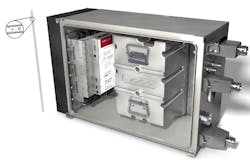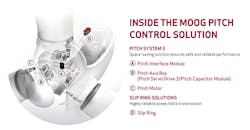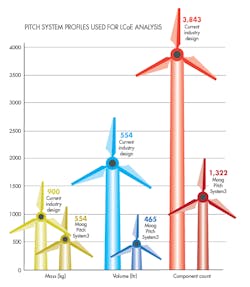Pitch controls adjust the blades in wind turbines by rotating them so that they use the right fraction of the available wind energy to get the most power output, all the while ensuring the turbine does not exceed its maximum rotational speed. This maintains the turbine’s safety in the event of high winds, loss of electrical load, or other catastrophic events.
The pitch control monitors and adjusts the angle of the wind turbine’s rotor blades, which can measure up to 65 meters long, and thus controls the rotational speed of the turbine. Although pitch controls play a vital role, they account for less than 3% of a wind turbine’s capital expense.
But “research shows that pitch subsystem failures account for 23% of all downtime in wind turbines … more than any other turbine component or subsystem. … and pitch subsystems tallied the highest percentage of all component failures in wind turbines at more than 21%,” according to Prasad Padman in a 2016 article in North American Clean Energy magazine. And when a wind turbine goes offline due to unplanned maintenance, the owner/ operator can lose, on average, several thousand dollars per day.
Challenges in Pitch Control
Pitch controls are in the hub of the wind turbine where each blade requires a pitch actuator. To repair or service a pitch controller, technicians must usually travel to a remote site, climb 260 to 525 ft (80 to 160 m), unless the turbine comes equipped with a lift or small elevator. The expense of getting to the device requires that engineers develop low-maintenance, compact mechanism. When pitch controls do break, the ideal replacement is something a maintenance technician can carry, along with a satchel or kit of tools.
Besides the challenges of getting to the turbine’s nacelle, equipment there must survive ambient temperatures ranging from −40° to 130° F (−40° to +55°C) and prolonged vibrations that put great stress on components. Whether it’s scheduled or unscheduled, reducing the frequency and length of downtime is crucial for wind turbine operators. This means the pitch controls should be simple to maintain, relatively compact, lightweight, and reliable.
Harnessing Aerospace Technology
With backgrounds in developing motion control systems for aerospace applications, Moog engineers looked at wind turbine pitch controllers as fertile ground for innovation. So over the past few years, they have gathered around white boards examining technologies from all areas of the company that might help them design a more reliable, compact, and low-maintenance pitch controller. Fortunately, the company has an extensive background in creating devices and components for the aerospace industry, which prefers integrated systems that are light and small. This gave Moog a leg up on the pitch control design.
The company’s first generation of pitch controllers used brushed DC motors, a time-tested and common design. But Moog opted for brushless motors; brushed DC motors use too many mechanical devices, such as contacts and relays, plus they are prone to wear. Brushed motors also require cleaning every six months—not exactly appealing to wind-farm operators and maintenance technicians looking to minimize the number of trips to the turbine’s nacelle and hub.
To control the pitch angle of the blades when power fails, engineers have historically relied on motors with lead-acid batteries to supply back-up energy to pitch controllers. Lead-acid batteries last three to four years (sometimes five) and are difficult to monitor. These batteries work thanks to chemical reactions, and extreme heat and cold affects those reactions. One solution is to warm or cool the battery, depending on the need. But this requires more components, controls, and energy, plus it introduces another risk of failure.
To overcome the challenges with lead acid batteries, Moog chose an ultracapacitor, which is not a chemical device but a passive electrical component. Through testing, engineers predict ultracapacitors will have operational lives of over 10 years. Still, Moog’s engineers continue evaluating the latest technologies for even better back-up power.
The axis box for the Pitch System 3 fits inside the turbine’s hub and there is one for each turbine blade. It contains the pitch servo derive and capacitor module. (The ruler on the left is marked in centimeters.)
Customers for wind turbines want longer mean times between failures. (Who wouldn’t, except turbine repair people?) Inside the turbine hub, which rotates at 10 to 20 rpm, electromechanical components present another risk of failure due to gravitational forces, not to mention vibrations and shock. So the Moog designers eliminated many electromechanical components from its next-generation design. This reduced also weight in building the next-generation pitch system, which was dubbed Moog Pitch System 3.
Here’s the layout of the Pitch System 3’s internal layout as it sits inside the hub of a wind turbine.
To increase reliability, the design team redefined and simplified the energy-distribution architecture. They also centralized key functions in core modules, then optimized and tested the controller for a service life of more than 20 years.
A typical five-year old pitch controller (and there are many of these operating around the world) can have between 2,000 and 4,000 parts. These include thousands of wires and termination points, which present many opportunities for something to go wrong. The Pitch System 3 reduces the traditional part count by 60% and extends the time between scheduled maintenance.
When components fail, they add to the already high cost of putting a technician onsite to make repairs. Stretching the time between scheduled maintenance and drastically cutting component failures lowers the cost of electricity to turbine owners. DNV GL, a Norwegian firm that supplies services for several industries (including maritime, renewable energy, oil & gas, electrification, food & beverage, and healthcare), recently released a study on pitch controls. It calculated that wind farm owners who install compact and lightweight controllers on a 3 MW turbine could trim operating costs by as much as $1.71/MWh.
Beyond the Wind
The same technology and design approach used on the pitch controllers could soon be seen in more traditional power generation plants. Gas turbines have requirements not unlike those of a wind turbine. For instance, moving the vanes on gas-fired turbines lets operators vary the airflow into the turbine to keep it running at peak performance. Currently, turbine makers rely on control mechanisms that are standard industrial hardware. But taking a design-for-purpose approach—similar to that used for wind turbines, particularly with environmental considerations and reliability in mind—engineers could likely improve the vane controllers and have them withstand the rugged environments where vibration and dirt can take a toll on sensitive components.




